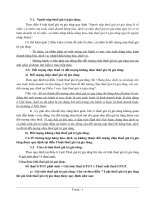BÀI GIẢNG ORGANIC CHEMISTRY chapter3
Bạn đang xem bản rút gọn của tài liệu. Xem và tải ngay bản đầy đủ của tài liệu tại đây (228.48 KB, 21 trang )
ORGANIC CHEMISTRY
Dr Nam T. S. Phan
Faculty of Chemical Engineering
HCMC University of Technology
Office: room 211, B2 Building
Phone: 38647256 ext. 5681
Email:
1
Chapter 3:
INTRODUCTION TO
REACTION MECHANISMS
Reaction mechanism: the description of the
step-by-step process by which reactants
are changed / converted into products
Nucleophilic substitution
Nucleophilic addition
Electrophilic substitution
Electrophilic addition
Elimination
2
NUCLEOPHILIC SUBSTITUTION
REACTIONS (SN)
• A nucleophile: an electron-rich species that can
form a covalent bond by donating 2 electrons to a
positive center
• A nucleophile is any negative / neutral molecule
that has 1 unshared electron pair
• Substitution reaction: chemical reaction in which
1 atom / group replaces another atom / group in the
structure of a molecule
• In a nucleophilic substitution reaction, a
nucleophile attacks / bonds with the positive center
3
4
BIMOLECULAR NUCLEOPHILIC
SUBSTITUTION REACTION (SN2)
5
UNIMOLECULAR NUCLEOPHILIC
SUBSTITUTION REACTION (SN1)
6
Note: slow step is rate-determining step
7
ELIMINATION REACTIONS
In an elimination reaction:
+ Groups / atoms are eliminated from a reactant
+ A double bond is formed between the 2 carbons
from which atoms are eliminated
8
BIMOLECULAR ELMINATION (E2)
Strong base
9
10
UNIMOLECULAR ELMINATION (E1)
11
Weak base
12
ELETROPHILIC ADDITION
REACTIONS (AE)
• Electrophilic: electron-seeking / loving
• Most electrophiles:
+ Are positively charged
+ Have an atom which carries a partial positive
charge
+ Have an atom which does not have an octet
of electrons
An electrophilic addition reaction is an addition
reaction where carbon-carbon double bonds or
triple bonds are attacked by an electrophile 13
14
•Not a
carbocation,
but a cyclic
halonium
ion
• More
stable than
carbocation
15
NUCLEOPHILIC ADDITION
REACTIONS (AN)
The carbonyl group is polar because the oxygen, being
more electronegative, has greater share of double-bond
electrons
The partial positive
carbon can be attacked
by nucleophiles
The addition of nucleophiles to the carbon
atom of the carbonyl group in nucleophilic
addition reactions
16
Reaction mechanism
Positive
center
A nucleophile
Rate-determining step
slow
fast
17
Examples:
Nucleophiles
18
ELECTROPHILIC SUBSTITUTION
REACTIONS (SE)
In an electrophilic substitution reaction, an
electrophile substitutes for a hydrogen of an
aromatic compound
Although benzene has 3 double bonds, the overall
reaction is electrophilic substitution rather than
electrophilic addition
19
Reaction mechanism
Rate-determining step
An electrophile
20
Examples:
An electrophile
Rate-determining step
21









